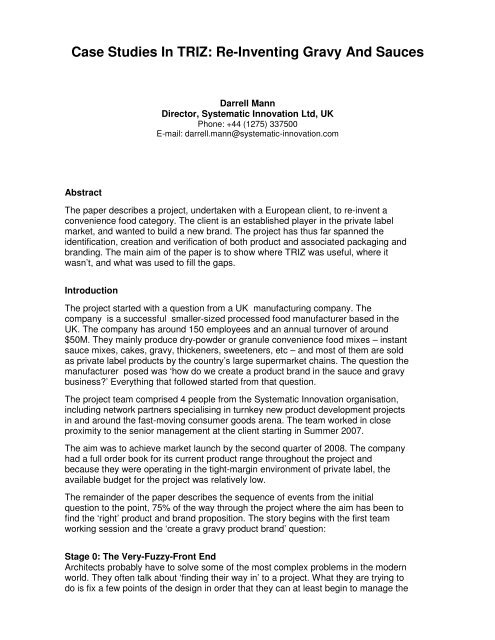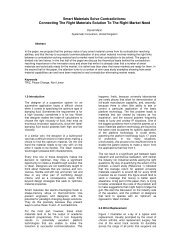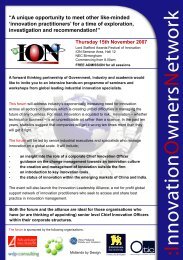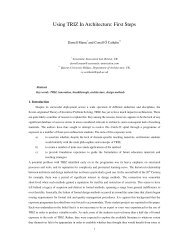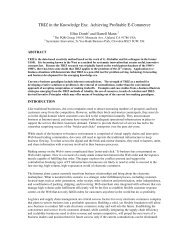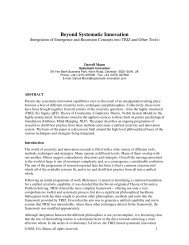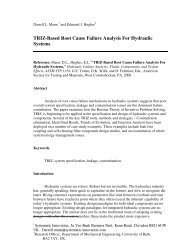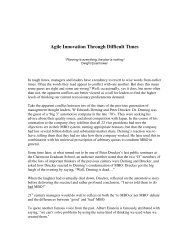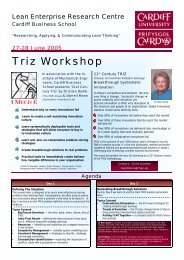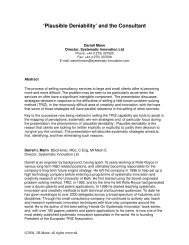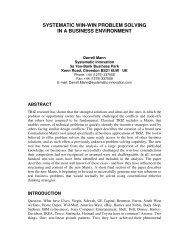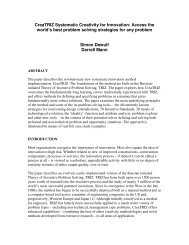Case Studies In TRIZ: Re-Inventing Gravy And Sauces - Systematic ...
Case Studies In TRIZ: Re-Inventing Gravy And Sauces - Systematic ...
Case Studies In TRIZ: Re-Inventing Gravy And Sauces - Systematic ...
You also want an ePaper? Increase the reach of your titles
YUMPU automatically turns print PDFs into web optimized ePapers that Google loves.
<strong>Case</strong> <strong>Studies</strong> <strong>In</strong> <strong>TRIZ</strong>: <strong>Re</strong>-<strong>In</strong>venting <strong>Gravy</strong> <strong>And</strong> <strong>Sauces</strong><br />
Darrell Mann<br />
Director, <strong>Systematic</strong> <strong>In</strong>novation Ltd, UK<br />
Phone: +44 (1275) 337500<br />
E-mail: darrell.mann@systematic-innovation.com<br />
Abstract<br />
The paper describes a project, undertaken with a European client, to re-invent a<br />
convenience food category. The client is an established player in the private label<br />
market, and wanted to build a new brand. The project has thus far spanned the<br />
identification, creation and verification of both product and associated packaging and<br />
branding. The main aim of the paper is to show where <strong>TRIZ</strong> was useful, where it<br />
wasn’t, and what was used to fill the gaps.<br />
<strong>In</strong>troduction<br />
The project started with a question from a UK manufacturing company. The<br />
company is a successful smaller-sized processed food manufacturer based in the<br />
UK. The company has around 150 employees and an annual turnover of around<br />
$50M. They mainly produce dry-powder or granule convenience food mixes – instant<br />
sauce mixes, cakes, gravy, thickeners, sweeteners, etc – and most of them are sold<br />
as private label products by the country’s large supermarket chains. The question the<br />
manufacturer posed was ‘how do we create a product brand in the sauce and gravy<br />
business?’ Everything that followed started from that question.<br />
The project team comprised 4 people from the <strong>Systematic</strong> <strong>In</strong>novation organisation,<br />
including network partners specialising in turnkey new product development projects<br />
in and around the fast-moving consumer goods arena. The team worked in close<br />
proximity to the senior management at the client starting in Summer 2007.<br />
The aim was to achieve market launch by the second quarter of 2008. The company<br />
had a full order book for its current product range throughout the project and<br />
because they were operating in the tight-margin environment of private label, the<br />
available budget for the project was relatively low.<br />
The remainder of the paper describes the sequence of events from the initial<br />
question to the point, 75% of the way through the project where the aim has been to<br />
find the ‘right’ product and brand proposition. The story begins with the first team<br />
working session and the ‘create a gravy product brand’ question:<br />
Stage 0: The Very-Fuzzy-Front End<br />
Architects probably have to solve some of the most complex problems in the modern<br />
world. They often talk about ‘finding their way in’ to a project. What they are trying to<br />
do is fix a few points of the design in order that they can at least begin to manage the
enormous number of variables present in any building project. Although not quite on<br />
the scale of some of the projects taking place in Dubai at the moment, the gravy<br />
project nevertheless felt very fuzzy during the first session.<br />
Our chosen ‘way in’ to the project was to conduct a simple Why-What’s Stopping<br />
Analysis. We could have chosen more rigorous tools (such as Perception Mapping),<br />
and indeed kept open the possibility that we still would, but the pressing need<br />
seemed to be to obtain a better understanding of the hierarchy of problems and<br />
opportunities. We expected this at least would tell us whether the job was going to be<br />
about re-defining the whole company or to change the labelling on an existing<br />
product. A summarised output from the session is presented in Figure 1:<br />
Broader P roblem<br />
S ustainable profit<br />
<strong>In</strong>creasing margins,<br />
increasing business<br />
stability<br />
Why do I want to solve<br />
this problem?<br />
Why else?<br />
Original P roblem(start here)<br />
create a gravy product<br />
brand<br />
Narrower P roblem<br />
C reating a self-building<br />
brand requiring<br />
little budget<br />
creating a low-cost,<br />
novel (protectable)<br />
G ravy innovation<br />
What’s s topping me<br />
solving this problem?<br />
What else?<br />
L imited budget<br />
available<br />
L ack of unique<br />
selling proposition<br />
Figure 1: <strong>In</strong>itial Why-What’s Stopping Analysis<br />
The main output from this template is the hierarchy of problems found up the central<br />
spine of the picture. Upon closer examination, the consensus view of the team and<br />
the client that the level the gravy problem had to be tackled was ‘how to generate<br />
some kind of unique solution that would make the product stand out in such a way<br />
that the brand would build itself’. This became the ‘obvious’ problem simply because<br />
of the limited brand-building budget and the knowledge that building a brand in the<br />
FMCG sector is notoriously expensive. At least traditionally. The next question was<br />
whether anyone had solved a similar problem before.<br />
We used a template combining elements of <strong>TRIZ</strong> and Blue Ocean Strategy in order<br />
to add some structure to a search (<strong>Re</strong>ference 1). This template was designed initially<br />
to help companies to decide where they should innovate. Three innovation spaces<br />
are included in the template:<br />
a) Find a ‘blue ocean’ space where no-one else is playing<br />
b) Make use of a strong trend direction, singularity or trend conflict<br />
c) Solve a contradiction<br />
The basic idea behind the structure is that the more of these three things present in<br />
an innovation, the more likely it is to be successful. By doing all three things<br />
companies create the biggest chance of creating a breakthrough success. Figure 2<br />
illustrates where some of the most successful FMCG innovations of recent times fit<br />
onto the template. Danone Actimel, for example, is a good example of a stellar<br />
success that has simultaneously played in all three spaces – they found a blue<br />
ocean by creating a new ritual of drinking a yogurt at breakfast; they tapped into
strong consumer drives towards both increasing health consciousness and also<br />
desire for extreme convenience; and with L.Cassei Immunitas they made consumers<br />
aware of and ‘solved’ the contradiction of ‘good bacteria’.<br />
Figure 2: Beyond Blue Ocean – Who’s Already Solved A Similar Problem?<br />
<strong>Re</strong>flect on this template and some of the examples from the perspective of ‘who<br />
achieved their success without having a large brand-building budget’, two examples<br />
stood out from the rest; <strong>In</strong>nocent and <strong>Re</strong>d Bull. <strong>In</strong>nocent is the more recent of the<br />
two and as yet a phenomenon only in the UK. <strong>In</strong>nocent make smoothies that are<br />
‘100% fruit, 100% natural, 100% of the time’. As such they are very clearly tapping in<br />
to the same health consciousness trend that Actimel uses so successfully. <strong>In</strong>nocent<br />
have the additional advantage here though that there is a parallel government health<br />
initiative to get people eating their ‘5 a day’ portions of fruit and vegetables. <strong>In</strong>nocent<br />
also plays in the ‘solve a contradiction’ space. With strong parallels to Virgin this<br />
time, their very similar name is intended to send the clear message that this is not<br />
the usual big-business company. A name is one way of sending out this message.<br />
Using 100% recycled packaging and giving away 10% of their profits to a charitable<br />
foundation was a more tangible way of convincing the consumer that here, unlike<br />
other big companies, was a brand that stood for being cast from a different mould.<br />
Aside from direct ideas growing from <strong>In</strong>nocent (e.g. create the savoury/gravy version<br />
of the <strong>In</strong>nocent smoothie), the template told us that the low-budget brand building<br />
challenge probably required us to play in at least two of the three spaces:<br />
Stage 0.5: The Slightly-Less-Fuzzy-Front-End – Voice Of The Product<br />
Next we embarked on a <strong>TRIZ</strong> analysis of the current products produced by the<br />
company. The intent here was to define opportunities in the ‘solve a contradiction’
space on the Figure 2 template. Solving a contradiction means either literally doing<br />
that (i.e. using the Contradiction Matrix/<strong>In</strong>ventive Principles) or more generally<br />
making some kind of discontinuous jump. <strong>In</strong> order to explore the ‘jump’ space, a<br />
‘Voice Of The Product’ (<strong>Re</strong>ference 2) analysis was conducted for both product and<br />
packaging. The results of the initial analysis is shown in the Evolution Potential radar<br />
plots in Figure 3.<br />
evolution jumps to<br />
powders, pastes &<br />
ready-mades<br />
Figure 3: <strong>Gravy</strong> Granule and Packaging – Current Evolutionary State<br />
Also shown in the plots are some of the jumps being made by competitors in the<br />
market space. Although a more detailed analysis revealed that the gravy-mix industry<br />
as a whole had been relatively static for a good number of years (there had in fact<br />
been just two trend jumps since the 1950s), it was also seen that competitors had<br />
jumped and that the manufacturer had not.<br />
Based on the untapped potential, the team conducted a short ‘trend-storm’ exercise<br />
in order to identify some of the possible jumps that the gravy granules themselves<br />
and the surrounding packaging could make. Proprietary restrictions prevent us from<br />
describing all of the ideas generated, but here are some of the ideas and the trends<br />
that the idea emerged from in order to provide a flavour of the outcome of this<br />
session:<br />
• Hollow/porous granules (improved dissolution; Space Segmentation)<br />
• Addition of vitamins/other nutrients (added nutrition; Mono-Bi-Poly)<br />
• Different colours (emphasise multi-functionality; <strong>In</strong>creasing Colour)<br />
• Segmented flavour/thickening (ease of use; Action Co-ordination)<br />
• Active elements (effervescence/improved dissolution; Smart Materials)<br />
• Transparent packaging (pre-purchase visibility; <strong>In</strong>creasing Transparency)<br />
• Segmented packaging (separate ingredients; Space Segmentation<br />
• Colour-change packaging (increased feedback; Smart Materials)<br />
All in all, this ‘Voice of the Granule’/’Voice of the Packaging’ exercise saw the<br />
generation of over a hundred possible future evolution directions. When we<br />
attempted a short contradiction analysis to complement this activity (typical<br />
examples: we want fresh-and-long-life, easy-to-make-and-authentic), the number of
ideas increased further. This quantity of ideas turned out to be more of a problem<br />
than a solution to the innovation/brand challenge. <strong>In</strong> order to help solve that problem<br />
the team moved next to the other side of the ‘Voice’ story and to the second space<br />
on the Figure 2 ‘where to innovate’ template:<br />
Stage 0.5: The Slightly-Less-Fuzzy-Front-End – Voice Of The Customer<br />
We were at the beginning of day three of the project by this stage. What we were<br />
now looking for was a ‘quick and dirty’ perspective on ‘the consumer’. We knew we<br />
wanted to do this as we didn’t have the time or resources to test a hundred different<br />
concepts with real consumers. The chosen starting point was a high level look at<br />
societal patterns. The closest thing to <strong>TRIZ</strong> in this area is the Fourth Turning work on<br />
generational cycles conducted by US historians William Strauss and Neil Howe<br />
(<strong>Re</strong>ference 3). Figure 4 plots a graph of some of the more recent generations,<br />
adjusted for differences between the UK and US.<br />
Figure 4: Generation Cycles For The Last 60 Years<br />
The basic finding of the Fourth Turning research is that societies pass through<br />
repeating generational cycles. The ultimate in order emerging from chaos; the way<br />
we were brought up as children in turn affects the way that we bring up our own<br />
children; the way our friends were brought up likewise affects us as we affect them.<br />
One big, fuzzy self-organizing system - according to Strauss and Howe. <strong>In</strong>cidentally<br />
our own ongoing research programme in the UK (<strong>Re</strong>ference 4). Figure 4 contains a<br />
lot of information. Let’s start with the diagonal lines. These denote the boundaries<br />
between generations and also the trajectory of a person’s life. Someone born in 1962<br />
is thus seen to be right on the boundary between what turned out to be the Baby<br />
Boomer and X generations. <strong>In</strong> 2008 that person born in 1962 has followed the line up<br />
the ‘age’ y axis, and is therefore now 46. Parallel to this generational boundary is the<br />
more recent shift between Generation X and Generation Y (Y babies were born<br />
during the period ~1982-2000). This is significant in the context of the gravy problem.<br />
If we look at the state of the generations in 2008, we see there are some significant
cross-over points by the intersection between the generational boundaries and the<br />
vertical 2008 line. The most important one as far as gravy is concerned is that the<br />
oldest of the Generation Y cohort are now becoming parents. Also potentially<br />
significant:<br />
• a new (as yet un-named) generation is in their early youth and being<br />
exposed to gravy for the first time<br />
• the grandparents of this generation are typically Baby Boomers (this is<br />
potentially significant since gravy - at least in the UK - is closely associated<br />
with Sunday dinners where families traditionally get together)<br />
• Generation X parents, now in their late 30s and 40s have generally been<br />
brought up to fend for themselves which typically meant not-cooking, but<br />
rather eating out. We had to speculate how this generation of non-cooks<br />
(albeit ones that are now starting to feel guilty about it) impacted on the<br />
use of gravy.<br />
It is our belief that all consumer trends emerge from these generational patterns<br />
(<strong>Re</strong>ference 5), so in terms of our ‘where to innovate’ objective of finding important<br />
consumer trends and trend conflicts, we used the Figure 4 data to help focus the<br />
search for such conflicts. Again, the main aim in this paper is to describe a process<br />
rather than specific and proprietary answers, but some of the items emerging from<br />
this study were as follows:<br />
• Generation X guilt plus protected-in-youth Generation Y parents are the<br />
source of the increasing reaction to sedentary lifestyle and unhealthy diet<br />
trends. The ‘five portions a day’ phenomenon is a direct result of these<br />
directions and trying to solve the conflict of a generation of parents who<br />
can’t cook.<br />
• Because there is also a strong trend toward single parent families and<br />
more travel, the ‘family dinner’ happens less frequently and when it does<br />
happen it is more likely to be at a restaurant than at home<br />
• The new generation currently in early childhood is less likely to be exposed<br />
to gravy – and very definitely home-made gravy – than the two preceding<br />
generations.<br />
• The Silent generation were the most recent ones for whom ‘gravy’ was a<br />
significant feature of a meal. ‘<strong>Gravy</strong>’ again in the UK is perceived often as<br />
the ‘best’ part of a dinner; the part containing both the goodness (it is<br />
usually made from the water in which vegetables are cooked) and also as<br />
a ‘mask’ for often flavourless things underneath. <strong>In</strong> large part this<br />
perception exists because the Silent generation was first exposed to gravy<br />
during their early youth – at the same time World War 2 and all of its food<br />
rationing was happening. Today the Silent generation are heading into the<br />
great-grandparent role and as such are quite remote from family life.<br />
• If the Silent generation was a gravy generation, the generation that<br />
followed them grew up in a time of more abundance, freedom and a desire<br />
to travel. Baby boomers were thus exposed to different foods from around<br />
the globe. As such, it seems likely that the importance of gravy was<br />
significantly lower than it had been for the Silents.<br />
• The main traditional purchasers of gravy mixes, being women responsible<br />
for a family, are currently in transition from Generation X to Generation Y.
Stage 1 Gate: The Fuzzy-Front-End – Short-List Of Concepts<br />
Once we started the job of matching Voice Of The Customer issues with Voice Of<br />
The Product ideas and concepts, we had the basis for drawing up a short-list of<br />
solutions we thought needed to be taken forward and exposed to consumers.<br />
Our aim at this review was to identify a maximum of nine product concepts that<br />
would be taken forward to consumer trial. To some extent this number was fixed no<br />
more scientifically than by the available budget. On the other hand, one thing we did<br />
try and do during the review was to effectively create a ‘design of experiments’ menu<br />
of product concepts which in turn, using a 4x4 Taguchi matrix allowed us to explore<br />
the significance of four different technical variables. The thinking behind this was that<br />
instead of getting a yes/no good/bad result for each of the nine, we should be able to<br />
assess the significance of different constituent parts of each concept.<br />
Stage 1: Consumer <strong>In</strong>sight Sessions<br />
What we learned from the initial Voice Of The Customer sessions was that getting<br />
the perspectives of the different generations was going to be relevant. So when we<br />
were configuring who should be present during the sessions, we made sure we had<br />
statistically relevant levels of representation from Generations X and Y and Baby<br />
Boomers. The other main dimension used to select members of the insight sessions<br />
was Spiral Dynamic thinking level (<strong>Re</strong>ference 5). This was something of a departure<br />
from tradition (normally the industry standard A, B, C, D social classification<br />
framework is used), one that was justified on the grounds that a) we knew how to<br />
cross-correlate between the two frames of reference, and b) we had a stronger<br />
database to connect between the Spiral Dynamic levels and consumer trends at<br />
large.<br />
Without wishing to complicate the description more than is necessary, another<br />
variable we felt it was important to explore was the cultural and behavioural<br />
differences between different regions of the UK. Specifically between the ‘North’ and<br />
‘South’ of the country.<br />
Over 30 insight sessions were held in different places and with different consumer<br />
groups, each session having between 12 and 20 participants. Participants were<br />
placed in either kitchen or supermarket settings and the nine storyboards were used<br />
as the basis for informal interview discussions. <strong>Re</strong>cognising the frequently observed<br />
phenomenon that consumers on these sorts of panel usually provide the answers<br />
they think the panel wants to hear rather than what they actually thought, the<br />
interview sessions were conducted in such a way as to counter the effect as much as<br />
possible (see <strong>Re</strong>ference 7 for some insight into the methods deployed).<br />
A period of data analysis followed the completion of the first 30 sessions. This<br />
analysis revealed a number of insights that were in turn used to help design a<br />
subsequent series of deep-dive immersion trials, putting a number of key consumer<br />
archetypes in prolonged exposure experiments. For example, in one of the more<br />
extreme experiments a family was denied access to gravy during all of their meals for<br />
a week.<br />
We’ve barely been able to begin to describe the full extent of this work here; but the<br />
duration of this part of the programme was close to four months.
It often seems almost cruel to then be able to distil all of this activity down to insights<br />
that can be summarised in a sentence. However that is what the team was able to<br />
do. As might be expected, it cost a significant amount of time and money to obtain<br />
those insights and so the reader will forgive us for not revealing what we found here.<br />
Suffice to say that the team found some real innovation ‘nuggets’ – insights which<br />
identified some very clear contradictions that (if they could be solved) were highly<br />
likely to create genuine breakthrough solutions, not just in the gravy arena, but also<br />
in a number of surrounding areas. Suffice to say also that, as far as the innovation<br />
process is concerned we were able to make some clear and justifiable<br />
recommendations from the Voice of the Product menu of concepts to the company’s<br />
senior management team.<br />
Stage 2 Gate: The ‘Right’ Proposition<br />
Whether the underlying contradictions behind the consumer insight will ever be made<br />
public remains to be seen. What will be seen are the new products that were<br />
presented to the management and subsequently approved for a further round of<br />
consumer testing. This time, with actual taste-right, look right products.<br />
The Stage 2 gate review was also an opportunity to bring together initial thoughts on<br />
pricing structure, route to market, brand design and preferred methods of promotion<br />
and advertising. Again the limited space here has no intention or ability to do justice<br />
to the size and scope of this work. <strong>TRIZ</strong>, as it turns out, was explicitly brought back<br />
into the story for what turned out to be a day’s worth of identifying the most<br />
appropriate manufacture technology for what looks like being the eventual product<br />
concept, but this is again a tiny proportion of a much bigger activity. Figure 5 gives a<br />
helicopter view of both this <strong>TRIZ</strong> injection and the other times that <strong>TRIZ</strong> was explicitly<br />
utilised through the project.<br />
S tage 0 Definition<br />
J un-07 J ul-07 Aug-07 S ep-07 Oct-07 Nov-07 Dec-07 J an-08 F eb-08 Mar-08 Apr-08 May-08 J un-08<br />
(TR IZ )<br />
S tage G ate R eview<br />
<strong>In</strong>itial C onsumer <strong>In</strong>sight S essions<br />
Analysis<br />
Deeper-Dive <strong>In</strong>sight S essions<br />
S tage G ate R eview<br />
(TR IZ )<br />
Detail F ormulation<br />
P rototype & P ackaging<br />
C onsumer Trials<br />
R oute To Market C hannels<br />
Advertising/ Brand S trategy<br />
S tage G ate R eview<br />
P roduction P lanning & C ontract<br />
P roduct L aunch<br />
Figure 5: Overall Project Timescale Chart Showing <strong>TRIZ</strong> <strong>In</strong>jections<br />
<strong>TRIZ</strong> accounted for about 2% of the total in person-hour terms. Given the work that<br />
still has to be done to get the new product to market, it does not look as if this figure<br />
will increase.<br />
The bar chart also shows that the project - at the time this paper had to go to press -<br />
was still some months away from launch. Given that the failure rate of new product
launches in the FMCG sector is globally in the high 90 percents, and in the UK is<br />
presently around 98%, this looks and feels like a risky case study to put forward as<br />
an example of ‘what <strong>TRIZ</strong> did’.<br />
Whether the project turns out to be a success or not (the team is convinced that we<br />
will be in the 2% of successes), the point here is not about ‘what <strong>TRIZ</strong> did’ but rather<br />
what it ‘did not’ do.<br />
All of the team agree that <strong>TRIZ</strong> played a necessary role in setting the project in the<br />
right direction. It took a lot of the fuzziness from the project. It also, in forcing the<br />
team to think about continually looking for and challenging contradictions, ensured<br />
that everyone was focused on asking the right innovation questions throughout. But<br />
then 98% worth of ‘other’ activity starts to look like the 800lb gorilla in the room.<br />
Which might just be the main point.<br />
Summary<br />
Although the new-brand story is still ongoing at the time of writing, the project is close<br />
enough to the end to merit making some generic conclusions.<br />
<strong>TRIZ</strong> was used at the fuzzy beginning of the project to generate an understanding of<br />
what the real question was and then a portfolio of ‘Voice Of The Product’ ideas.<br />
Having used this Voice to generate close to a hundred ideas on possible directions<br />
that the gravy product and packaging could evolve, it was then necessary to<br />
determine which of those directions were the most likely to succeed in the UK<br />
market. At this point, <strong>TRIZ</strong> – classical <strong>TRIZ</strong>Z at least – was deemed to offer little if<br />
any capability. <strong>In</strong> order to at least begin asking the ‘which?’ question, we turned to a<br />
number of Voice Of The Customer tools. These tools included Spiral Dynamics,<br />
Fourth Turning, Culture Codes and NLP. What they did was provide the project team<br />
with insights into what questions they in turn should be asking when it came to the<br />
point of actually asking the customer on a face-to-face basis. Once actual consumer<br />
insight had been acquired and it was felt that the ‘Voice Of The Customer’ was<br />
sufficiently understood, it was possible to perform another iteration of matching the<br />
Customer and Product voices. Having made what seem to be the best connections,<br />
a final round of <strong>TRIZ</strong>-related work was required in order to help identify the most<br />
appropriate technology for manufacturing the product.<br />
<strong>In</strong> terms of proportion of project duration, given its use at the fuzzy front end of the<br />
project and again towards the end in helping to identify appropriate manufacture<br />
technology, (as quoted earlier) <strong>TRIZ</strong> was utilised for somewhere around 2% of the<br />
actual calendar time. <strong>In</strong> some ways this should be seen as a testament to the power<br />
of <strong>TRIZ</strong>. It did important things that would otherwise either not have been done at all<br />
or would have taken a lot longer. Whilst it is true that exposure to <strong>TRIZ</strong> had an<br />
influence on the project team for the remaining 98% of the project time, it remains<br />
clear that there are an awfully large number of necessary innovation steps that are<br />
well beyond the traditional <strong>TRIZ</strong> boundaries.<br />
Ultimately <strong>TRIZ</strong> formed a necessary but fundamentally insufficient part of the overall<br />
product and brand development process. So what might a necessary and sufficient<br />
innovation toolkit and philosophy comprise? To some extent – of course – the<br />
answer depends on the problem at hand. Different types of problems require<br />
different types of tools. What appears clear is that there is almost always going to be<br />
a need to look at situations from both the customer and the ‘product’ side, and that
ultimately these two things have to be connected together. Aside from the general<br />
conceptual concept of Ideality, <strong>TRIZ</strong> has little to contribute at the detailed level. For<br />
problem situations where the ‘customer’ is one or a small number of people then this<br />
may not be such a big problem. On the other hand, for products like gravy where the<br />
‘customer’ is potentially many millions of consumers, the need for more structured<br />
and comprehensive approaches appears more than clear. Things like Spiral<br />
Dynamics and Fourth Turning certainly help, but ultimately Thomas Edison might<br />
have hit the nail on the head when he said that innovation was 1% inspiration and<br />
99% perspiration. Crudely speaking, with <strong>TRIZ</strong> we doubled the ‘inspiration’ content of<br />
this project. Here’s hoping that that investment appreciably better than double our<br />
chances of a successful market introduction.<br />
<strong>Re</strong>ferences<br />
1) <strong>Systematic</strong> <strong>In</strong>novation E-Zine, ‘Beyond The Blue Ocean’, Issue 70, January<br />
2008.<br />
2) Mann, D.L., ‘Unleashing The Voice Of The Product <strong>And</strong> The Voice Of The<br />
Process’, paper presented at <strong>TRIZ</strong>CON06, Milwaukee, May 2006.<br />
3) Strauss, W., Howe, N., ‘The Fourth Turning: An American Prophecy’, Bantam,<br />
1998.<br />
4) <strong>Systematic</strong> <strong>In</strong>novation, ‘Generational Cycles’ series, every issue since<br />
September 2007.<br />
5) Graves, C.W., ‘The Never Ending Quest’, ECLET Publishing, Santa Barbara,<br />
2005.<br />
6) Rapaille, C., ‘The Culture Code: An <strong>In</strong>genious Way to Understand Why<br />
People Around the World Buy and Live as They Do’, Broadway Books, 2007.


